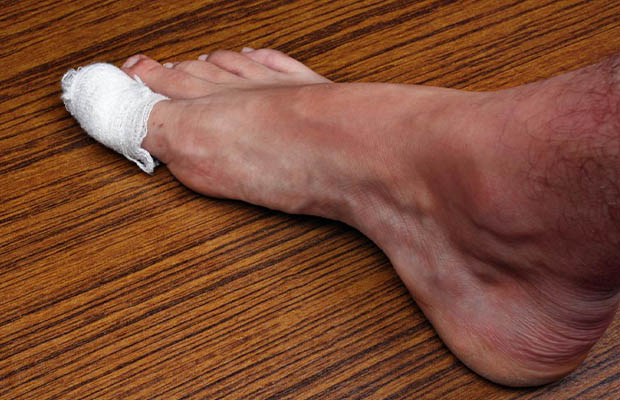Toenail Falling Off: Causes And Treatment

We discuss what to do when toenail falling off in this article. A detached toenail’s causes are also discussed, along with when to visit a doctor.
Though it’s a common condition, having a toenail come off can be painful. It’s typically brought on by a wound, a fungus, or psoriasis. Your toenail can also fall off due to chemicals, some medications, and serious illnesses.
Table of Contents
What Causes A Toenail To Fall Off?
Injury
You could lose a toenail from simple foot injuries. Your toenail can be damaged by things you drop on your foot, sports, and auto accidents.
Your toenail may appear black or purple underneath if it is injured. A subungual hematoma, which causes blood to gather under your injured toenail, is to blame for this. Nail separation from the nail bed is possible as blood accumulates beneath the nail. Your toenail may not fall off completely for a few weeks.
If more than 25% of your toenail is covered by the subungual hematoma, call your doctor. Your doctor may use a heated needle or wire to make a small hole in your toenail to release pressure if you experience throbbing or severe pain close to the hematoma.
Otherwise, you can treat your injured toe at home by:
- Soaking it in cold water for 20 minutes
- Elevating it
- Clipping any sharp or jagged edges of the remaining nail
- Cleaning any exposed part of your nail bed and applying an antibiotic ointment
- Applying a fresh bandage daily for the next 7 to 10 days, or until the skin hardens
- Taking nonsteroidal anti-inflammatory drugs (NSAIDs), such as ibuprofen (Advil, Motrin), to help with the pain
The time it takes for a toenail to fully regrow can range from six months to two years, depending on which toe it came off. To avoid any further injuries, make sure to wear comfortable shoes and closely trim the rest of your toenails.
Fungus
The toenail on your foot may eventually fall off due to fungi that develop between the nail bed and the toenail.
Symptoms of a fungal toenail infection include:
- Noticeably thicker toenails
- White or yellowish-brown discoloration on your toenails
- Dry, brittle, or ragged toenails
- Foul smell coming from toes
- Unusual toenail shape
A fungal infection of the toenail can develop from athlete’s foot. Due to poor blood flow in your feet, diabetes increases your risk of developing a fungal infection in your toenail.
Your nails become drier as you get older. They may also be more prone to cracking as a result, which would allow fungus to grow in your nail bed.
Depending on how severe the infection is, fungus infections of the toenails can be challenging to treat. In minor cases, the infection usually goes away on its own. If you have diabetes, it’s crucial to let your doctor know if you have any kind of foot infection because poor circulation can exacerbate the issue.
Antifungal medications applied topically or orally are frequently used to treat fungal toenail infections. Your doctor might advise either or both of them, depending on the severity of your infection. Generally speaking, topical over-the-counter medications are much less effective than oral antifungal medications. Additionally, they lessen the possibility of infection for your brand-new toenail.
Up to 12 weeks may be required for you to take your medication. The new toenail needs time to fully integrate before you can see any results. If you experience any unusual symptoms while taking oral antifungal medications, such as a rash or fever, let your doctor know right away.
The treatment of a fungal toenail infection can also be attempted at home. Rarely, you might require surgery to permanently remove the offending toenail.
You can prevent fungal toenail infections by:
- Keeping your feet dry
- Changing your socks often
- Wearing breathable shoes
- Keeping your nails neatly trimmed
- Disinfecting your nail clippers
- Wearing shoes in damp communal areas, such as spas or locker rooms
Psoriasis
Skin cells accumulate as a result of the autoimmune disease psoriasis. It can affect the toenails in addition to the skin, where it frequently manifests. A lot of nail psoriasis cases are mild and don’t bother people much. Your toenail may, on occasion, fall off due to a buildup of skin cells in the nail bed.
Symptoms of psoriasis on your toenail include:
- Pitting
- Thickening
- Unusual nail shape
- Yellow or brown color
- Chalky buildup under nail
Avoid using a sharp object to scrape away any extra skin beneath your nail because this increases the risk of your toenail coming off. Instead, warm water soak your feet while you file the edges of the remaining toenail. Keeping your feet and toenails moisturized can also be beneficial. Here, you can find a wide variety of moisturizers.
To treat your toenail and cuticle, your doctor might recommend topical steroids. The use of phototherapy may also be advised. You must expose the affected toes to UV rays as part of this treatment. Rarely, the remaining portion of your toenail may need to be removed.

When To Remove My Toenail?
It is crucial to keep the remaining portion of a toenail in place if only a portion of the nail has broken off.
In this situation, one should smooth it out by trimming or filing any jagged or uneven edges as opposed to removing them. Injuries won’t worsen or the nail won’t catch on socks or shoes as a result of this.
Clip off any nails that are still partially affixed to the nail bed or are still connected to other nails. The last nail should be clipped, then it should be filed smoothly.
Related Reading:
What To Do If Your Toenail Falls Off?
No matter what caused your toenail to fall off, there are a few things you can do immediately to prevent further issues.
Here are some quick tips:
- Do not attempt to remove the remaining toenail if only a portion of it has fallen off.
- Use nail clippers to carefully trim off the detached portion of your toenail if it is still joined to your toe in order to prevent it from catching on your socks or other items of clothing. If you don’t feel confident doing it on your own, your doctor can assist you.
- Any jagged or sharp edges should be filed down using a nail file.
- Apply an antibiotic ointment after cleaning your toe and making sure all debris is gone.
- Put a bandage over the area where your toenail has fallen off.
- If your toenail completely falls off or the area around it won’t stop bleeding, seek immediate medical attention.
How To Prevent Losing A Toenail?
There are some preventive measures to consider when doing activities that can help decrease your risk of losing a toenail such as:
- Avoid wearing shoes that press against your toes or are too small in the toe area.
- Keep the length of your toenails short.
- In your shoes, always wear padded socks.
When To See A Doctor?
A doctor should be consulted for the proper course of treatment if a fungus infection does not go away on its own.
If a person has an injury that worries them or if they think they may have an infection under their nail or around it, they should consult a doctor.
A doctor may be able to offer advice on the most effective course of treatment for skin and nail symptoms if a patient suspects psoriasis.
How To Keep The New Nail Safe?
After experiencing the agony of having a toenail fall off, you’ll start to notice a new nail forming after about six weeks (yay!) — but it’ll grow at your normal nail growth rate, says It typically takes a toenail a year to grow back from the cuticle to the tip, Dr. Batra. Here’s how to monitor the progress:
- Before the new toenail grows in, if you don’t know the reason why the old one fell off, be sure to find the problem and resolve it. Otherwise, the new toenail might be vulnerable to the same problem.
- Treat the new nail with antifungal medication if you lost the previous toenail due to a fungal infection.
- To prevent ragged edges from catching on socks and breaking further, keep the new nail smooth and filed.
- To avoid infections, keep your feet dry, swap out your socks frequently, and refrain from going barefoot in public restrooms.
- Pick socks that are breathable and wash your feet every day with soap and water.
- Consult a doctor if the new nail returns damaged or growing back unevenly.
- Keep the area dry and clean, and use over-the-counter antifungal medications if there is thickening or discoloration. Consult a physician for a stronger antifungal cream if it doesn’t clear up.
Final Words
Even though a toenail falling off is typically not a serious medical concern, it can be uncomfortable and annoying.
A toenail that has been damaged or is coming off may occasionally become infected or may indicate a more serious medical condition.
If your toenail won’t stop bleeding or you’re in a lot of pain, see your doctor. By keeping your feet clean and your toenails smooth and short, you can lower your chance of losing a toenail in the future.
Read More: Bruising On The Toenail
Tags: Toenail Falling Off